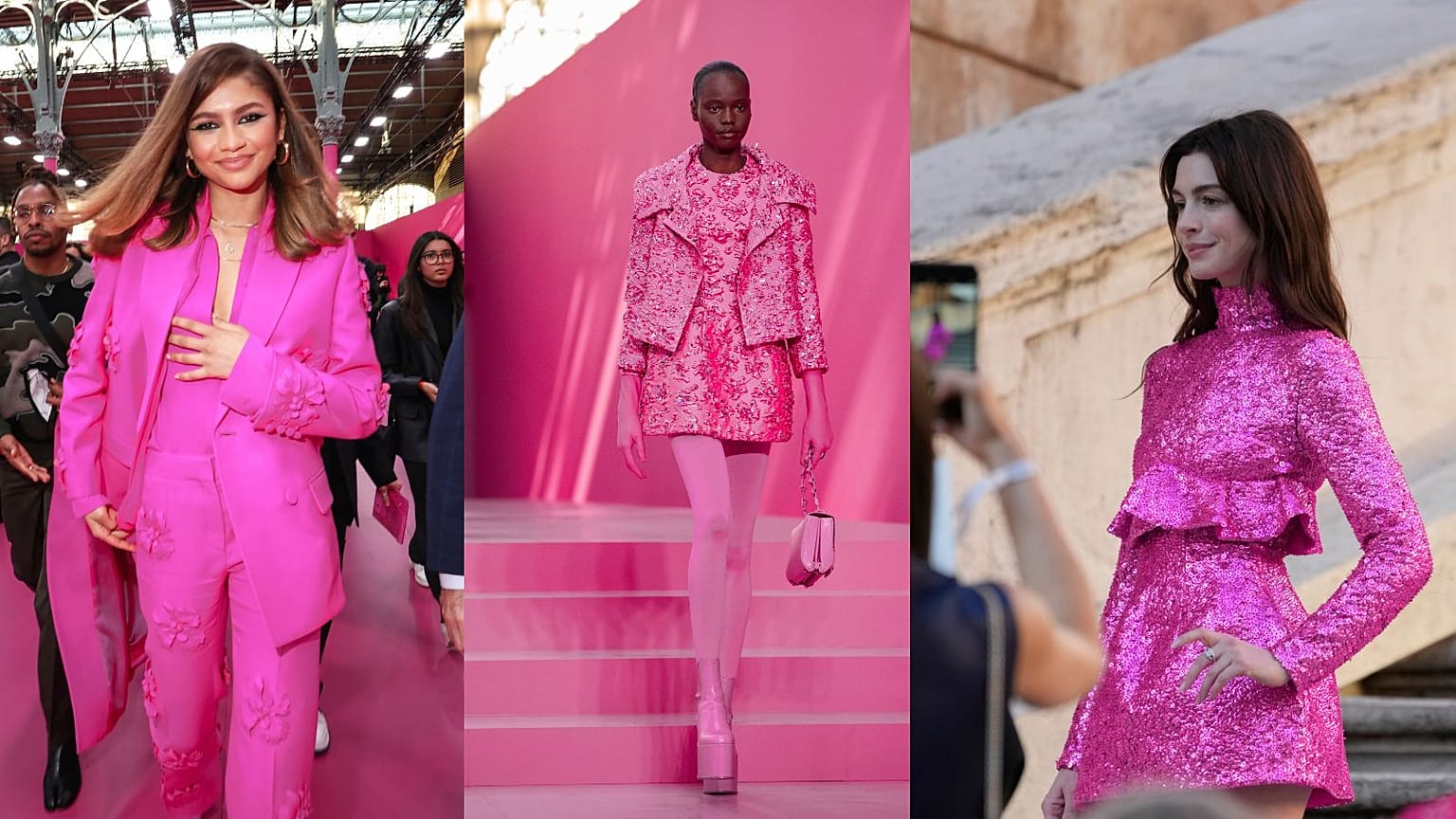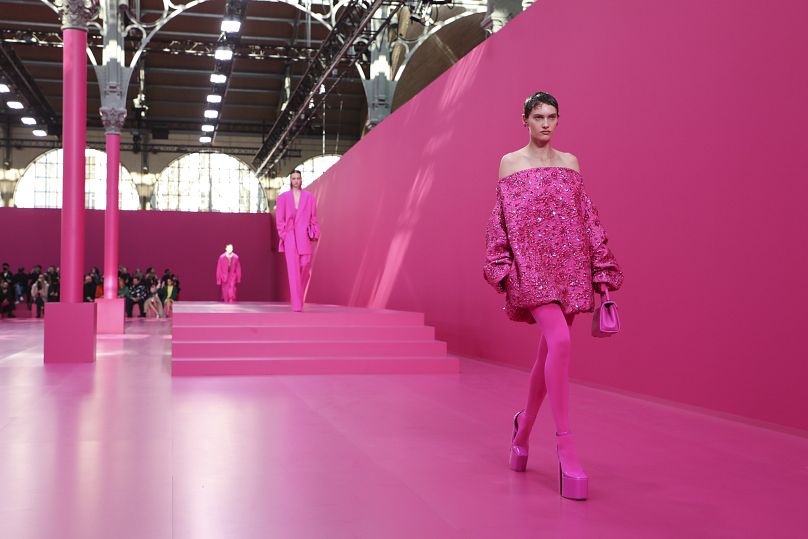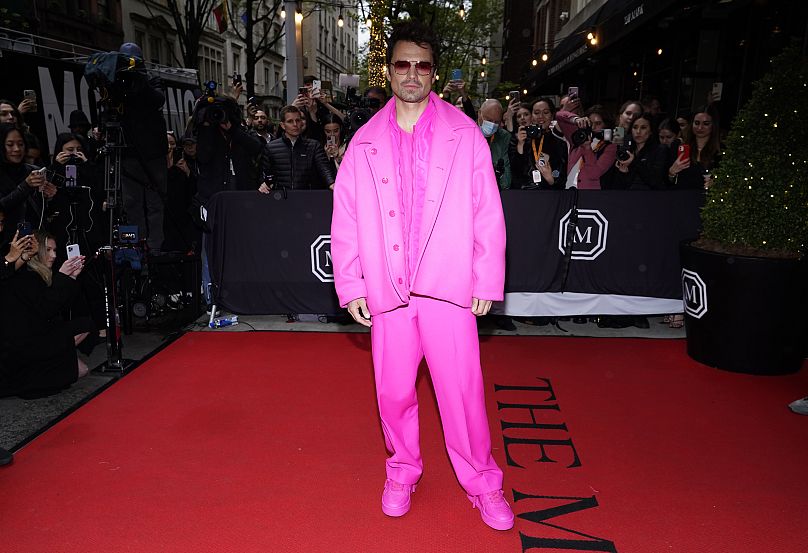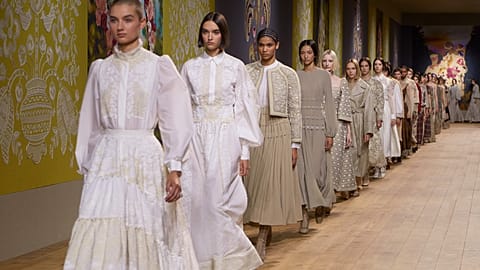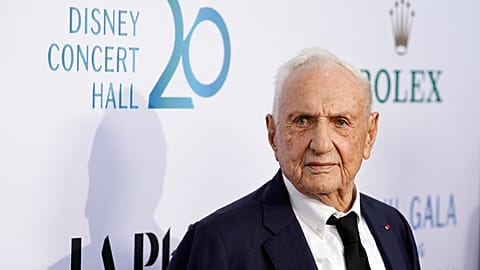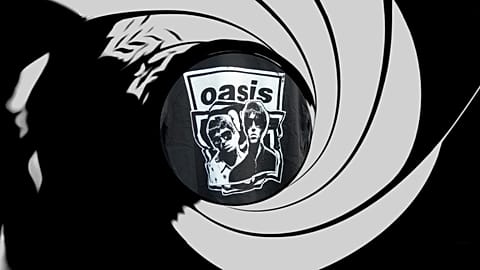Hyperfemininity is taking over the runway, red carpet and high street, but how did we get here?
Anne Hathaway walks the streets of Rome in a sparkling pink minidress carrying a miniature handbag.
The event she’s teetering to in hot pink platforms is a celebration of Valentino’s Haute Couture line at Rome Fashion Week. She was later photographed with fellow actresses Florence Pugh and Ashley Park in the front row, all wearing the same shade of bright pink.
Meanwhile, celebrities from Khloe Kardashian to Lizzo have been papped wearing hyperfeminine attire, Versace platforms have become a regular sighting on both high-streets and the red carpet, and memes of Greta Gerwig’s ‘Barbie’ are going viral before the film is even out.
But what’s painting the town pink? It’s Barbiecore, and it’s here to stay.
What is Barbiecore?
Glance at a glossy magazine or the runways of Paris and you’ll most likely be instantly blinded by a flash of colour.
“It is awesome to see so many designers and celebrities wearing so much colour,” says Barbiecore-enthusiast, blogger and textile designer Ashley Knight.
“Over the past year I’ve definitely noticed more colourful trends.”
Valentino’s Fall/Winter 2022 - 2023 collection saw pink platform heels, pink coats, and tailored pink parading down an entirely pink runway with pink walls. Balenciaga too have incorporated pink into their collections, leading to the trend getting that coveted Kardashian boost.
But it’s not just high-end fashion houses that are getting in on the act.
According to credit lender Clearpay, high-street fashion retail is seeing a Barbiecore boost with sales of blonde hair dye up 47 per cent, fuchsia clothes up 44 per cent, and scrunchies increasing by a massive 1099 per cent.
Meanwhile, a cursory search on social media will reveal #barbiecore everywhere on Instagram and TikTok, from those dressed up as human dolls to simple OOTD (outfit of the day) posts.
“I think it is a really interesting moment for Barbiecore,” says Alex Quicho, Head of Cultural Insights at Canvas8.
“It’s driven by the bottom up with the extreme trend fragmentation of TikTok. At the same time we are also seeing it from the top down in high fashion; a lot of collections reflect interest in hyper feminine aesthetics.”
Dopamine Dressing
Last year saw the cast of ‘The Devil Wears Prada’ reunite for the 15th anniversary of the cult film, in which Anne Hathaway plays the long suffering assistant of Meryl Streep’s Anna Wintour-inspired fashion editor Miranda Priestly.
In one memorable montage, Hathaway, having undergone a makeover from frumpy nerd to (quite literally) glamorous assistant, walks to work and undergoes six outfit changes along the way.
Each look is as mooted as the last; shades of dark, cream or tan characterising the air of a woman who looks good but also has a career; a million miles from Hathaway’s loud ensemble for the Valentino show.
“We’re seeing the end of the era of the girlboss and minimalism,” says Quicho.
“Things that were previously considered gauche or tacky; we have fallen straight back into that world.”
Barbiecore is part of a wider trend of dopamine dressing, whereby wearers ditch neutral tones in favour of loud patterns and garish colours.
“I love to wear colour,” says Knight.
“It is a really good mood booster for people, and we all need that at the moment.”
Y2K, Tumblr, and beyond
It’s not as though wearing pink is anything revolutionary. In fact, it could be seen as rather regressive.
A tour of Barbiecore TikTok will produce mood boards of Y2K celebrities like Paris Hilton, Britney Spears and Lindsay Lohan wearing pink miniskirts, pastel crop tops, and plastic sunglasses.
But these noughties icons have recently undergone a rehabilitation, with a reassessment of their tabloid treatment by social media users, aided by documentaries and high-profile court battles.
“People respect them as complex individuals now, as opposed to seeing them as tabloid fodder,” says Quicho.
This re-examination of an aesthetic associated with misogynistic headlines is symptomatic of the spirit of reclamation that Barbiecore imbibes. Bimbo, coquette and even the lobotomised housewife have all featured as trends on the more niche parts of Tumblr and Reddit, and Barbiecore has burst from this aesthetic-ecosystem.
“People want to reclaim those identities, but there is a distance from them being compulsory. If we were forced into it, this wouldn’t feel fun,” says Quicho.
“There is a separation where those people and those lives feel far enough away that you can do that.”
The Gender Politics of Barbiecore
In an era of gender-neutral fashion, a hyperfeminine trend can seem off topic, but perhaps the frills and frolics of Barbiecore show a move towards embracing a good time in a post-pandemic world.
It’s true that as the world emerged from lockdown, there were widespread predictions of a return to the roaring 1920s, with maximalism taking over from the minimalist aesthetics that took hold after the 2008 financial crash.
“I feel like there is a stigma, and there has been for a while, of dressing really feminine,” says Knight.
“The whole point of fashion is to have fun and for you to like your outfit. You get confidence and a lot of that is through colour for me. I want to be hyper feminine and I want to express myself as a woman.”
Reclaiming feminine identities - be it Y2K pop stars or ‘Feminine Mystique’-era styles - seems all part of the package, and it’s not just for women.
Sure, female celebrities are wearing pink, but men are experimenting too, and from the Oscars to the Met Gala, male celebs have been spotted sporting pink and frills.
Even James Bond actor Daniel Craig - the ultimate symbol of machismo - was spotted sporting a fuchsia velvet smoking jacket on the red carpet for the world premiere of the latest Bond adventure, 'No Time To Die'.
As the fashion spotlight shifts to the hyperfeminine for women, it seems for men there’s also a desire to be pretty in pink, as third-wave feminism breaks down the gender-binary and sweeps everyone along with it.
“People want to focus on structural change…and are finding we don’t need to throw out all the fun stuff,” says Quicho.
As minimalism bows out and trends like Barbiecore rise, maybe it’s time to revise the old adage to ‘girls - and everyone else - just want to have fun.'















